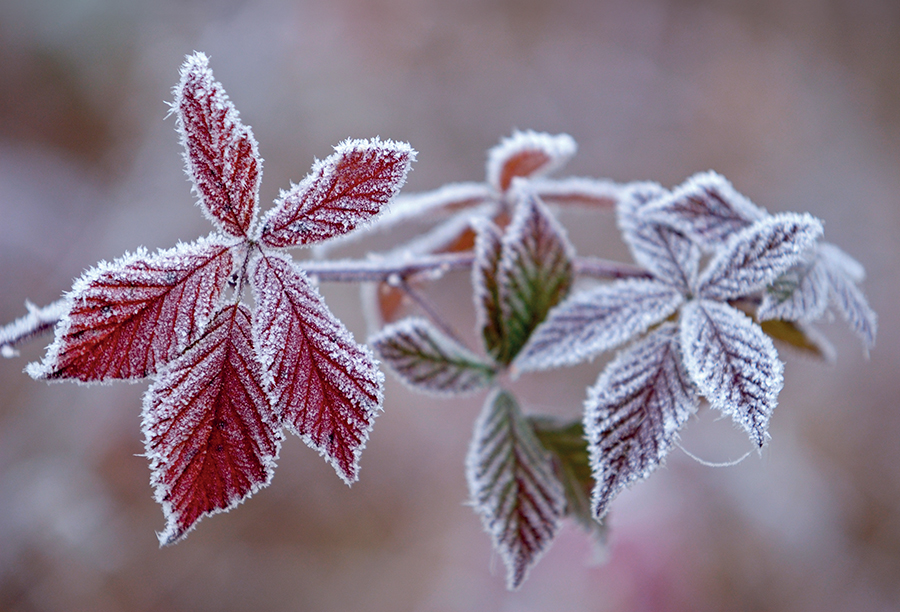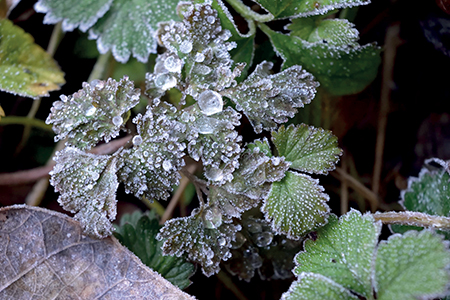Preparing soft fruit for the winter
6th November 2024
As the cropping season for soft fruit draws to an end, the focus switches to protecting crops over the winter months to give them the best possible start next spring.

The trend in recent years of milder, wetter, winters poses some specific challenges for soft fruit crops, from the increased risk of pests and diseases, to the lack of winter cold necessary for vernalisation and renewed vigour in the spring.
Once the polythene comes down, crops are inevitably at the mercy of whatever the winter weather brings; but there are things growers can do to help mitigate some of the risks, says Hutchinsons agronomist, Andrew Taylor.
Watch for aphids
Mild winters, such as 2023/24, can favour the build up of aphid populations, and this year that risk has been compounded by the fact that numbers of natural predators (e.g. wasps) have generally been much lower due to a cool, wet spring.
“The natural predator population has still appeared, but not in the numbers we’d usually expect,” Andrew says. “Now is an ideal time to inspect crops for overwintering aphids, and treat if required.”
Five species of aphid are commonly found on strawberries in the UK, including the strawberry aphid (Chaetosiphon fragaefolii) and the shallot aphid (Myzus ascalonicus).
The latter can migrate into strawberries over winter, as the crop acts as a winter host. “It is worth looking out for shallot aphid, especially – but not exclusively – in areas where a lot of onion or other host crops are grown.
“You tend to see the evidence of shallot aphid in the spring, when affected plants become stunted and are slow to grow away. This is due to the toxic saliva the aphid injected into the plant.”
In terms of control options in the autumn, Andrew says biological products will become less effective as temperatures decrease, so where aphid treatment is required, the main option is lambda-cyhalothrin. Prioritise crops where there is a history of shallot aphid, or those in close proximity to other host species in the local area, he says.
Caution should be exercised where biological controls, such as Amblyseius cucumeris, have already been employed earlier in the season to tackle tarsonemid mite (Phytodromus pallidus), he warns. “Generally, I’d be reluctant to go chasing aphids in that situation, because you want to give the biological control as long as possible to feed on the tarsonemid, which is probably more damaging overall than shallot aphid.”
During the winter months, aphid treatment is unlikely to be necessary, but once into February and crops start to be protected again, that is when they should be inspected closely for signs of overwintered aphids, and targeted treatments applied where necessary, he says.
Whitefly is another pest that can sometimes be an issue in mild autumns, more so in protected glasshouse environments. Generally, lower winter temperatures should naturally reduce populations, so treatment is rarely required in tunnel-grown crops.
Zero tolerance on vine weevil
One potentially devastating pest in fine-rooted plants, such as strawberries, blueberries and blackcurrants, is vine weevil, and growers are urged to check crops for any signs of activity and treat where necessary before winter.
Identifying the pest can sometimes be tricky, with adult feeding damage, or early senescence in the autumn, being the main indicators. Risk is often greatest in fields with a history of soft fruit growing, but it can also be introduced in new plant material, Andrew says. “It’s also worth noting that adults can easily move 100m or more, so the pest can migrate between fields.”
Some of the more vigorous strawberry varieties are less prone to vine weevil damage than others, he says. Florence and Symphony, for example, are both very vigorous plants that may tolerate a population of vine weevil by outgrowing the damage. In contrast, other varieties like Malling Centenary or Elsanta are less vigorous and would not survive as well. “Either way, vine weevil is a big threat, that can be devastating if left uncontrolled, so you don’t want it in crops.”

In blueberries, vine weevil often target the area around the neck of the plant where sawdust or bark mulch has been applied and new roots form. “Before you know it, the feeding larvae will girdle the outer bark of the bush, and then you just don’t get any production or new growth. There is zero tolerance for vine weevil in blueberries.”
To manage vine weevil risk, Andrew recommends the nematode-based biological control, Nemasys L, applied around the neck of the plant to prevent vine weevil larvae from feeding and causing further damage.
“Vine weevil control with nematodes is dependent on compost temperature though. Once it drops below 7ºC, it is probably getting too late. Products work by the nematode entering the vine weevil larva and releasing a bacteria which then stops it feeding; that bacteria generally doesn’t work very well below 7ºC.
“Some growers will apply it [Nemasys L] through irrigation systems, but personally, I like to see it applied directly around the neck of the plant using a hand lance because the nematode doesn’t travel very far from the point of application. It does require extra resources to do it this way, but that is money well spent as you just can’t afford to have a vine weevil population raging in your blueberries. The better you do the job, the better the control is.”
Winter protection
With most strawberries grown in bags or troughs on tabletops, Andrew recommends placing these on the ground over winter and covering with fleece to help protect against any potential frost damage.
“Last year, many growers would’ve probably got away with leaving strawberries on tabletops as there was virtually no frost over the winter; but if we do get periods of sub-zero weather in January or February, this can result in quite a lot of crown damage. Generally, strawberries survive a lot better on the ground than up in the air.”
Once strawberries have been moved, tabletop irrigation systems should be drained of water to reduce the risk of pipe damage during freezing conditions.
Autumn pruning of most raspberries should have been done by now, with the exception of late-cropping varieties, and canes tied in to reduce the risk of wind damage over winter. Andrew says there may be a need for some secondary spawn control post-pruning, and the main option for this in ground or pot-grown raspberries, is carfentrazone-ethyl.
In strawberries, if crops have been affected by phytophthora crown rot late in the season, growers could consider treating it with dimethomorph, but only while there is still vegetative growth, he continues. “Once growth reduces, the active is not transported through the crop as effectively.”
He also reminds growers to adhere to the limit on the total amount of dimethomorph that can be used per hectare each year.
“There are some biological products being used for phytophthora control in glasshouses that look quite promising, but at present they aren’t registered for use outside of permanent structures. I’m hopeful that if manufacturers can see there is some potential, then we might be able to get extended usage of these products in future.”
Looking ahead, Andrew notes that careful irrigation management during the spring establishment period is critical to disease control, as too much water can increase risk. “One thing we can’t regulate is the amount of moisture we get over the winter. If we do get prolonged periods of rainfall, then in some cases you can see disease levels increase. There’s not a great deal you can do about it in the winter; it’s only when growth restarts in the spring that you find disease levels are higher than when you put crops to bed in the autumn.
“We need some cold units over the winter ideally – that’s what makes a good plant in the spring. They get vernalised with the cold and have a bit more vigour to them when growth resumes.”
Slugs
Finally, slug populations have been very high this year – largely a legacy of the very mild, wet winter in 2023/24. This risk has carried through to the autumn, so should be managed with targeted pellet applications before winter, to reduce the background slug risk going into next spring, Andrew says.
Read more fruit news
